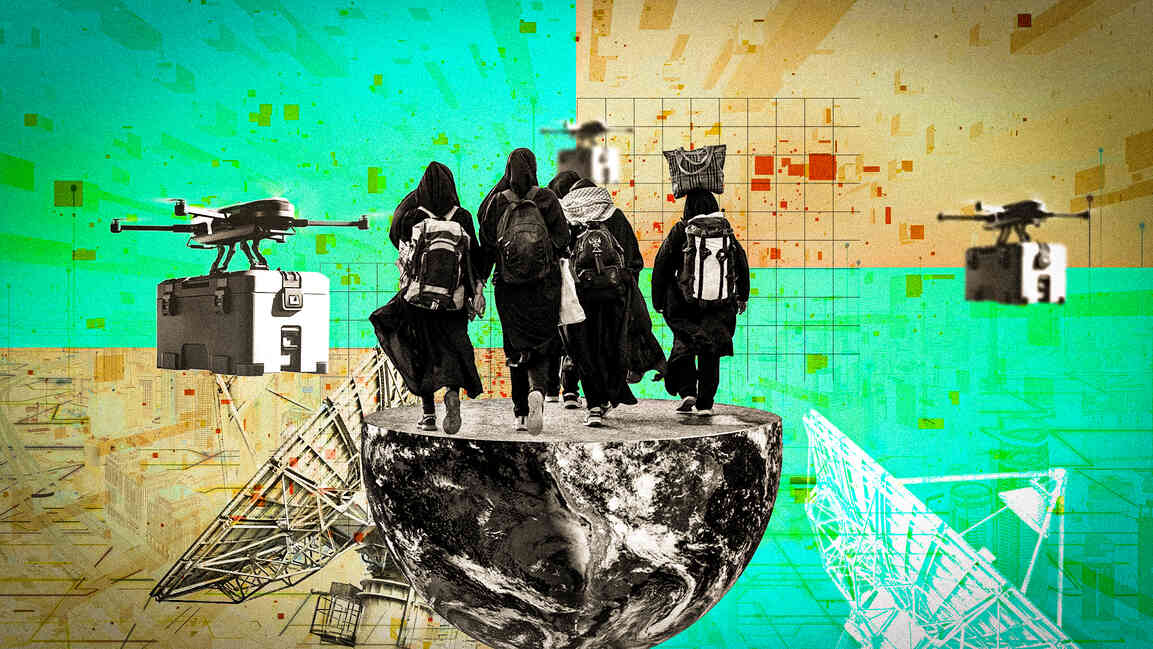- | 9:00 am
Can technology provide more efficient responses to humanitarian crises in the Middle East?
From fintech to unified databank, technology has opened the doors for new practices in humanitarian action

For a region that is no stranger to turmoil, recent news has taken many by surprise: commercial AI models and computing services from US tech giants are believed to have played a role in targeted killings in the ongoing war in Gaza, where, according to the UN, the situation is “apocalyptic.”
Things are bad. However, the consensus indicates that technology is a key enabler in making humanitarian response beneficiary-driven – a 180-degree change from the misuse in pulverized Gaza.
To invoke Kranzberg’s first law of technology: “Technology is not good; nor is it bad; neither is it neutral.” It is simply a tool that can be used to help solve problems and increase efficiency. Like other tools, if wrongly used, they create more problems than they solve.
From crowdsourcing data to next-generation technology, technology can improve humanitarian response in this region where already tens of millions of people in Lebanon, Yemen, and Syria depend on humanitarian aid, with most metrics forecasting a deteriorating trajectory, even before the ongoing war in Gaza convulsed it into the world’s worst humanitarian calamity.
The UN humanitarian agency (OCHA) recently admitted that the situation in the Middle East had probably “never been worse” since it began collating records in 1991.
TRADITIONAL HUMANITARIAN AID SYSTEMS
Apart from war, the region faces multiple and complex crises, displacement, and damage to vital health care, education, and water infrastructure due to drought, floods, and earthquakes, leaving millions in need of humanitarian assistance.
This troubling scenario calls for the planning, execution, and sustained operation of humanitarian operations. Central to this strategy is integrating technology with large-scale collaboration.
In the Middle East, traditional humanitarian aid systems, rooted in decades of goodwill and experience, are often fragmented and lack coordination, leading to slower response times and logistical bottlenecks. Giuseppe Saba, CEO and Board Member of Dubai Humanitarian, says, “One of the biggest challenges lies in the coordination required between affected countries and humanitarian organizations; this process alone can delay relief efforts significantly. In recent years, gathering and verifying information about available aid stock following a crisis has taken up to seven to ten days.”
Saba also says that delivering aid in conflict or disaster zones is further complicated by broken infrastructure and security concerns. “These conditions make last-mile delivery extremely difficult, often preventing life-saving support from reaching those who need it most when they need it most.”
SIMPLE TECH ADOPTIONS
As the needs of affected populations increase in scale and rescue teams work across the region to sustain life and livelihood in desperate conditions, a few simple tech adoptions, like mobile data collection within the humanitarian response, are among the more impactful developments.
Cash relief is one of the most efficient and effective forms of humanitarian response. By using electronic payments, people in need can be reached securely, faster, and more cost-effectively than many other forms of aid.
“Fintech solutions are making it easier to raise funds and directly transfer support to beneficiaries, minimizing administrative costs and improving efficiency,” says Saba.
Drones can be useful for assessing disasters if they complement existing assessment tools. Solar-powered lighting and IoT-enabled remote monitoring systems can ensure reliable and sustainable energy access in remote and underserved areas.
Several advanced technologies are transforming the response to humanitarian crises. Blockchain, for instance, ensures transparency and traceability in aid distribution, helping to provide assistance to the people who need it. The Internet of Things (IoT) gives real-time insights into the supply chain, allowing responders to track supplies and their condition.
Similarly, cloud-based platforms facilitate real-time collaboration among global teams, which is crucial when time is of the essence.
“These technologies not only improve the quality of life for affected communities but also enhance the efficiency and effectiveness of humanitarian operations,” says Albert Fuchet, Global VP of Access to Energy Business, Schneider Electric. “By leveraging cutting-edge approaches, private companies can help bridge the gap between immediate relief efforts and long-term development goals, ultimately fostering resilience and self-sufficiency among vulnerable populations.”
More often than not, private companies are viewed merely as donors in humanitarian crises, but their role can extend far beyond financial contributions.
Schneider Electric has developed several key technologies that are instrumental in the humanitarian sector. One notable example is the Mobiya solar lamp, a portable, reliable, affordable solution that provides basic lighting and phone charging capabilities. This innovation is particularly valuable in areas without grid electricity, offering a sustainable and cost-effective alternative.
Another is the Climate Smart Village solutions, supported by the EcoStruxure digital platform. This IoT-enabled, smart-powered, remote monitoring system supplies reliable power to households, streetlights, and other community loads. “It is an innovative, efficient, cost-effective solution that enhances energy access and supports community development,” says Fuchet.
However, Saba says using technology also comes with risks, especially in conflict zones. “Cyberattacks on aid infrastructure, the spread of misinformation, and the misuse of sensitive data like biometrics are real and growing concerns.”
That’s why, he adds, there’s a constant focus on implementing robust digital safeguards, strengthening ethical data governance, and promoting international cooperation to ensure these tools are used responsibly and in service of humanitarian goals.
INFORMATION-SHARING DURING CRISES
Information-sharing during humanitarian crises has long been challenging, mainly due to varying national regulations, customs procedures, and warehouse systems.
A further complicating factor is poor data management due to the large volume of data generated that often becomes fragmented, leading to delays in aid delivery. A databank is critical to streamline operations by reducing data fragmentation and enhancing operational efficiency.
Dubai Humanitarian has been at the forefront of a shift by launching the Humanitarian Logistics Databank to streamline and speed up emergency response. It serves as a centralized, standardized platform for tracking aid supplies, and categorizes items under globally recognized Harmonized System (HS) codes, making it easier for logistics partners to communicate and coordinate effectively.
“Before the Databank, no unified global system was to track humanitarian aid and assets across borders. As of April 2025, the platform displays aid stocks worth over $200 million ready for dispatch. These resources cover vital sectors such as health, shelter, logistics, education, food security, water, and sanitation,” says Saba.
This platform connects real-time data on life-saving aid available at global humanitarian hubs in Dubai, Italy, and Panama—the first three markets to be integrated as of April 2025. Saba says, “By offering visibility into existing aid supplies, the databank enables affected communities to identify and request support quickly, drastically reducing the time spent on planning and verification during crises.”
A COLLABORATIVE APPROACH
Efficiency comes when we open up our data, start collaborating more, and focus on what factors are limiting our ability to respond efficiently.
The key is improving collaboration and increasing sharing of information between humanitarian agencies, government departments, aid facilitators, logistics partners, corporate donors and individual volunteers.
“Collaboration is absolutely crucial. The complexity and scale of challenges related to energy access require concerted efforts from various stakeholders,” says Fuchet.
Partnerships between international and private companies can drive innovation, scale projects, and ensure that energy access initiatives are inclusive and effective.
“This collaborative approach helps to ensure that solutions are tailored to the specific needs and contexts of the communities they aim to serve, thereby driving sustainable impact,” adds Fuchet.
According to Saba, partnerships are critical, especially with researchers, academic institutions, and the private sector. These collaborations, he says, bring much-needed innovation to the table, whether through advanced tracking technologies, secure digital payments, or smarter logistics and packaging solutions.
“The technologies and know-how developed with the private sector help the humanitarian actors boost the speed, efficiency, and sustainability of aid operations, ensuring that support gets to where it’s needed most, faster and with a smaller environmental footprint,” Saba adds.
To reshape aid so it is fit for the 21st century, where crises have far-reaching impacts, technology is only one part of the solution. Collaborating across organizations, especially with private companies, and thinking from the perspective of those affected by crises is crucial.






































